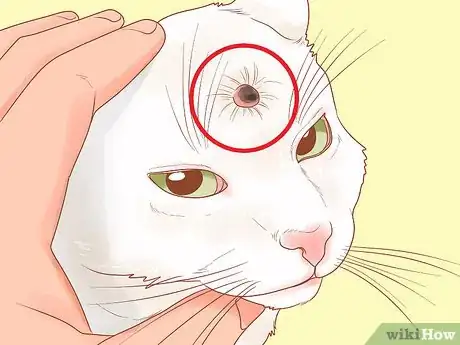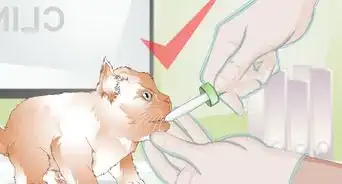This article was co-authored by Jamie Freyer, DVM. Dr. Jamie Freyer is a Licensed Doctor of Veterinary Medicine based in Washington. With over ten years of experience in clinical practice and industry, she specializes in veterinary medicine and surgery, animal behavior, and animal genetics. Dr. Freyer holds a BS in Life Science from The University of Portland and a DVM from Oregon State University.
There are 7 references cited in this article, which can be found at the bottom of the page.
This article has been viewed 176,245 times.
When it comes to skin cancer, a cat's best friends are its hairy coat and pigmented skin. Their dense fur shields their skin from UV rays and acts like a permanent sunscreen, which means that cats are less prone to skin cancer than people or thin-furred animals. However, cats can still get skin cancer. The most common feline skin cancer is squamous cell carcinoma (SCC). If you have a cat, you should be on the lookout for signs that it has skin cancer so that it can be treated as quickly as possible.[1]
Steps
Finding Lumps on Your Cat
-
1Look for lumps or discoloration. According to veterinarian Jamie Freyer, "Any strange bump or lump that shows up suddenly is something you want to look into." Skin cancer usually creates an area on the skin that is discolored and raised. When playing with your cat or cuddling up with it, take the time to look over its body for areas of discolored skin. Also look for areas where the cat's fur is out of place, perhaps due to a growth on the skin underneath.[2] Freyer suggests "bringing your cat to a veterinarian if you notice any bumps or growths, so they can take a biopsy, figure out what the mass is, and make a treatment plan."
-
2Feel your cat's body for lumps.[3] Because cats are covered in so much fur, its also important to feel your cat's body for signs of skin cancer. Feel for lumps and bumps on the skin in areas that are covered with fur and areas that are less covered.[4]
- While skin cancer is often related to sun exposure, and thus occurs in areas with less fur, there are some kinds that are not related to sun exposure at all. Happily, cats are less likely than other animals to get skin cancer that is not UV triggered, such as mast cell tumors.
Advertisement -
3Be especially diligent with looking for skin cancer on white cats. Squamous Cell Carcinoma (SCC) most commonly affects white noses, eyelids, and ears. This is a direct result of UV exposure to thin-furred skin that lacks pigment. A sun-loving white cat is the most common kind of cat to develop SCC, so you should regularly look for signs of this disease on white cats.[5]
- Indeed, if the cat has one black ear and one white, the white ear is much more likely to be affected by SCC.
-
4Have all lumps assessed by a veterinarian. It is true that some signs related to skin cancer should spark your immediate concern, such as rapid growth, redness, or ulceration. Veterinarian Jamie Freyer stresses that "there is no guarantee a small, slow-growing lump is harmless or harmful." This is why it is important to have all lumps assessed by a veterinarian.[6]
- Some aggressive tumors are great mimics, and take on the characteristics of innocent lumps, such as being superficial or slow growing. However, at some point in the future, they may become aggressive.
- It is difficult to distinguish a harmless skin lump from a sinister one, just by looking at it with the naked eye.[7] The only way to tell for sure whether or not a lump is harmful is to have the lump removed and a biopsy of it sent to the lab.[8]
Assessing a Lump
-
1Check the growth rate of a lump. Skin lumps are less likely to be sinister if they are slow growing, meaning they don’t perceptibly change from one month to the next. Fast-growing lumps are called aggressive tumors. These often have the ability to spread to other parts of your cat's body. These types of lumps grow so quickly that you can often see a change from week to week.[9]
- When you first find a lump, measure it with a ruler and record the measurement. Repeat the measuring process every week so that you can establish if the lump is changing or not.
-
2Assess whether the lump is under the skin or above it. A lump that sits discretely on the surface of the skin, has a definite border, and is not infiltrating the surrounding tissues is more likely to be a wart, cyst, or harmless skin mass than skin cancer. Skin cancer more often is embedded in the skin and the mass of it can be felt under the skin.[10]
-
3Look for dark pigment on the lump. Black pigment in a pale skinned animal is a warning sign when it comes to skin cancer. Dark pigment is frequently associated with more serious cancers such as malignant melanoma, thus a dark-colored lump must never be ignored.[11]
-
4Watch to see if your cat scratches or chews at the lump. Skin cancer can cause irritation, which means that your cat might scratch or chew on the lump to relieve that irritation. Some of the more serious cancers, such as mast cell cancer, contain histamine granules that can make the lump very itchy.[12]
-
5Monitor for any inflammation or ulceration. Cancerous lumps tend to look inflamed, which means that the skin looks pinker than the surrounding tissue. When you first find a lump, look at the tissue surrounding it and see if that area is red or inflamed.
- In the early stages of squamous cell carcinoma, non-pigmented skin becomes inflamed and looks darker pink than the surrounding skin. The skin will take on a scaly appearance and it can be mistaken for ringworm.
- Ulceration means that the lump breaks open and becomes a wound. If you notice this, seek medical help for your cat.
-
6Look for irregularly shaped lumps. Cancerous lumps often take on irregular shapes. This means that they lack a round shape, as regular lumps are generally round.
- The lump instead infiltrates deeply into the skin, so that the skin appears “glued” down to the tissue beneath.
-
7See if the skin becomes darker in color. With squamous cell carcinoma, if your cat continues to lie in the sun, the inflamed areas may take on an angry red color. There is also a chance that the skin will begin to erode; if this happens, ulcers will begin to form.
- If the cancer affects an ear, the edge of the ear may become irregular in shape, almost as if small bites have been taken out of it.
Seeking a Medical Diagnosis
-
1Protect your cat from the sun if you spot signs of skin cancer. Apply sunblock to your cat’s sensitive skin until you can take it to see a vet. You can also keep your cat indoors on sunny days to prevent it from lounging in the sun. Close the shades to further block UV rays.
- If possible, get a sunscreen that is made specifically for cats. If there is none available in your area, use a sunscreen designed for children and choose the highest SPF available.
- Always check the ingredients and avoid using a lotion that contains octyl salicylate and zinc. These are not good for cats, as they may swallow the product and be exposed to potentially toxic effects while grooming.
-
2Have your cat seen by a vet. It is unwise to make assumptions about skin lumps on cats. Skin cancer is rare, but when it happens it is often of the more serious sort. With this in mind, if you find a lump on your cat, get it checked by a veterinarian.[13]
- Call your veterinary office and tell them what you have found. Make an appointment to have your cat seen as soon as possible, so that if there is a problem, you can begin treatment right away.
-
3Have a fine needle aspiration done.[14] A fine needle aspirate (FNA) involves harvesting a small sample of cells from the lump with a hypodermic needle. It allows the veterinarian to inspect the cells for signs of cancerous growth but it does run the risk of missing cancerous cells due to the small size of the sample.[15]
- This is a non-invasive procedure that is done with the cat fully conscious and most cats tolerate the process well.
-
4Get a biopsy done.[16] A biopsy involves removing a wedge of tissue from the lump and sending it to be assessed at a lab. If the lump is easily removed, then an excisional biopsy may be performed. This means the vet will surgically remove the lump and will send a portion away for histology at a lab.
- A histology test determines if the lump is cancerous.
Expert Q&A
-
QuestionIs a lump always cancer?
 Jamie Freyer, DVMDr. Jamie Freyer is a Licensed Doctor of Veterinary Medicine based in Washington. With over ten years of experience in clinical practice and industry, she specializes in veterinary medicine and surgery, animal behavior, and animal genetics. Dr. Freyer holds a BS in Life Science from The University of Portland and a DVM from Oregon State University.
Jamie Freyer, DVMDr. Jamie Freyer is a Licensed Doctor of Veterinary Medicine based in Washington. With over ten years of experience in clinical practice and industry, she specializes in veterinary medicine and surgery, animal behavior, and animal genetics. Dr. Freyer holds a BS in Life Science from The University of Portland and a DVM from Oregon State University.
Licensed Veterinarian Not necessarily! Lumps can also be benign, fatty, or caused by abscess. Abscesses are especially common in outdoor cats, and tend to form after they're bit, poked, or roughed up in some way.
Not necessarily! Lumps can also be benign, fatty, or caused by abscess. Abscesses are especially common in outdoor cats, and tend to form after they're bit, poked, or roughed up in some way.
References
- ↑ http://www.petmd.com/cat/conditions/cancer/c_ct_squamous_cell_carcinoma_skin
- ↑ http://consciouscat.net/2012/04/30/how-to-perform-a-home-health-check-for-your-cat/
- ↑ Jamie Freyer, DVM. Licensed Veterinarian. Expert Interview. 8 October 2021.
- ↑ http://consciouscat.net/2012/04/30/how-to-perform-a-home-health-check-for-your-cat/
- ↑ https://www.vet.upenn.edu/docs/default-source/ryan/oncology-handouts/sccincats.pdf?sfvrsn=4
- ↑ https://www.petfinder.com/cats/cat-health/find-a-lump-on-cats-skin/
- ↑ Jamie Freyer, DVM. Licensed Veterinarian. Expert Interview. 8 October 2021.
- ↑ https://www.petfinder.com/cats/cat-health/find-a-lump-on-cats-skin/
- ↑ Small Animal Internal Medicine. Nelson & Couto. pp407
- ↑ Small Animal Internal Medicine. Nelson & Couto. pp407
- ↑ Small Animal Internal Medicine. Nelson & Couto. pp407
- ↑ https://www.vet.upenn.edu/docs/default-source/ryan/oncology-handouts/sccincats.pdf?sfvrsn=4
- ↑ https://www.petfinder.com/cats/cat-health/find-a-lump-on-cats-skin/
- ↑ Jamie Freyer, DVM. Licensed Veterinarian. Expert Interview. 8 October 2021.
- ↑ Small Animal Internal Medicine. Nelson & Couto. pp1150-1151
- ↑ Jamie Freyer, DVM. Licensed Veterinarian. Expert Interview. 8 October 2021.
About This Article
To recognize skin cancer in cats, use your fingers to feel for lumps all over the cat's body and part the fur to look closely at the skin for irregularly shaped lumps with dark pigment. A lump that sits on the surface of the skin and has a definite border is more likely to be a wart, cyst, or harmless skin mass, but it's still important to get lumps checked by a vet. You can also watch to see if your cat scratches or chews at the lump, since skin cancer can cause irritation and look inflamed. To learn more about cancer treatments for cats, read on!












































































Medical Disclaimer
The content of this article is not intended to be a substitute for professional medical advice, examination, diagnosis, or treatment. You should always contact your doctor or other qualified healthcare professional before starting, changing, or stopping any kind of health treatment.
Read More...